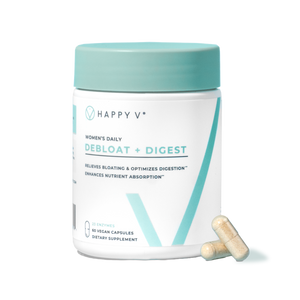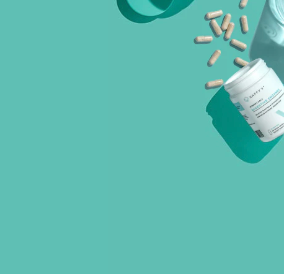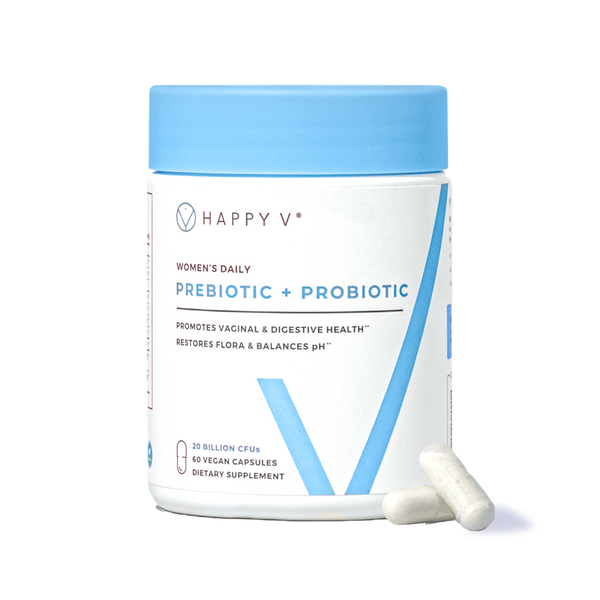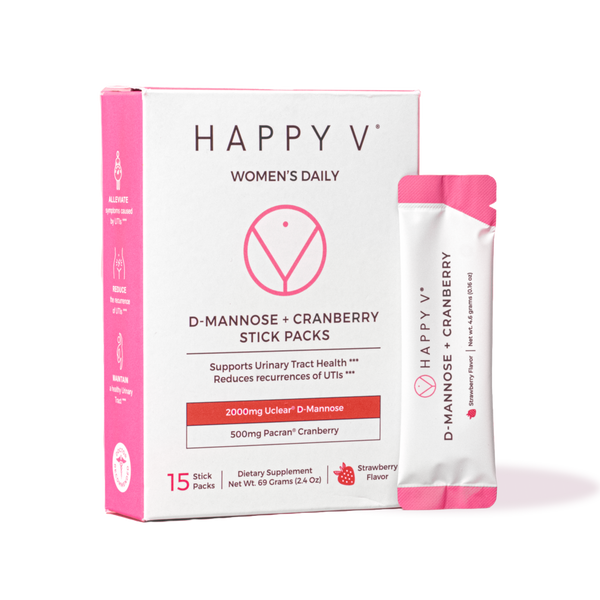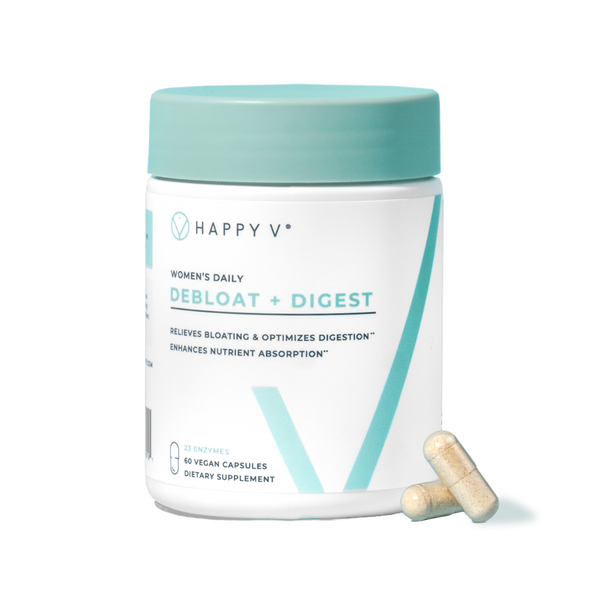- Fact Checked
- November 05, 2025
- 6 min read
Vaginosis vs. Vaginitis: What’s the Difference—And Why It Matters
Table of Contents
Table of Contents
Vaginosis, vaginitis… same thing, right? Not exactly.
While they might sound interchangeable (and involve some of the same symptoms), these vaginal conditions have different causes, treatments, and implications for your health. If you’re not sure which is which, don’t worry. We’re here to clear up the confusion and help you understand what’s going on down there so you can take control of your health.
This post is for informational purposes only and does not constitute medical advice. See full disclaimer below.
What’s the Difference Between Vaginosis and Vaginitis?
These two terms sound similar and often get lumped together, but they actually mean different things in the world of women’s health.
- Vaginitis is the umbrella term. It refers to any inflammation of the vagina, which could be caused by a whole variety of things, from an infection to an allergic reaction to hormonal shifts during menopause1.
- Vaginosis, on the other hand, is more specific. It’s most often used to describe bacterial vaginosis, an overgrowth of harmful anaerobic bacteria like Gardnerella vaginalis that upsets the normal balance of lactobacilli in the vaginal microbiome2.
So while all vaginosis is vaginitis, not all vaginitis is vaginosis.
Common Symptoms of Vaginitis
Vaginitis symptoms vary depending on the cause, but common signs include:
- Vaginal discharge (thin, thick, white, yellow, or even frothy)3
- Vaginal itching or irritation
- Burning during urination
- Pain or discomfort during sex
- Vaginal odor (sometimes described as fishy)
If you're noticing anything unusual when it comes to your vaginal health, schedule an appointment with your doctor. A pelvic exam and a vaginal swab from your healthcare provider can help get to the root cause of your symptoms and put you on the path to wellness.
Types of Vaginitis and What Causes Them
Like we said, vaginitis is a pretty broad term. It refers to a range of symptoms that can be caused by a variety of things, with the most common being:
1. Bacterial Vaginosis (BV)
- Caused by: Overgrowth of harmful bacteria and loss of lactobacilli4
- Symptoms: Fishy odor, gray or white discharge, mild irritation
- Risk factors: Douching, multiple sexual partners, recent antibiotic use5
2. Yeast Infection (Vulvovaginal Candidiasis)
- Caused by: Overgrowth of Candida (a type of fungus)6
- Symptoms: Thick, white “cottage cheese” discharge, intense itching, redness7
- Risk factors: Hormonal changes, antibiotics, tight clothing, high estrogen levels8
3. Trichomoniasis
- Caused by: Trichomonas vaginalis, a protozoan parasite and sexually transmitted infection (STI)9
- Symptoms: Frothy, yellow-green discharge, itching, soreness, burning
- Risk factors: Unprotected sex, multiple sexual partners
4. Atrophic Vaginitis (Vaginal Atrophy)
- Caused by: Decreased estrogen levels, often after menopause or during breastfeeding10
- Symptoms: Dryness, vaginal irritation, painful intercourse11
- Risk factors: Menopause, postpartum period, lack of estrogen12
5. Allergic/Noninfectious Vaginitis
- Caused by: Irritants like soaps, spermicides, tampons, lubricants, or synthetic underwear
- Symptoms: Burning, itching, no abnormal discharge
Diagnosis and Treatment
It’s important not to try to diagnose the cause of your vaginitis yourself. Your doctor is the most qualified person to do that and will usually begin with a pelvic exam and medical history review.
Your healthcare provider may also take a swab to examine vaginal secretions under a microscope (wet mount), test pH levels, or run additional STI screenings.
Treatment depends on the type of vaginitis:
- BV: Metronidazole or clindamycin13
- Yeast infections: Antifungal medications (prescription or over-the-counter)
- Trichomoniasis: Single-dose oral antibiotics like metronidazole14
- Atrophic vaginitis: Estrogen therapy and vaginal moisturizers15
- Allergic reactions: Removing irritants and soothing inflammation
How Probiotics Can Help
After antibiotics or during periods of hormone fluctuations (hi, menopause), your vaginal microbiome can take a hit. That’s where probiotics come in.
Happy V’s doctor-formulated probiotic contains clinically studied strains of lactobacilli like Lactobacillus acidophilus and L. rhamnosus to help:
- Rebalance vaginal flora
- Reduce recurrence of BV and yeast infections
- Support pH levels and immunity
- Soothe inflammation of the vagina and vulva
In preclinical testing, Happy V’s specific probiotic blend significantly reduced the presence of infection-causing bacteria such as Candida albicans and Gardnerella vaginalis, two of the most common culprits behind vaginitis and BV. These results suggest that consistent use of the formula may help reinforce the vaginal microbiome’s natural defenses and reduce the risk of overgrowth.
If you’re navigating recurring vaginitis, menopause symptoms, or high-estrogen birth control methods, adding probiotics to your routine can be a proactive way to support balance and prevent flare-ups. Just make sure to check in with your doctor before starting any new supplement.
Prevention Tips
Whether you're prone to vaginosis or other types of vaginitis, symptom prevention starts with everyday habits. The best things you can do for your vaginal health are to:
- Ditch the douching and fragranced hygiene products
- Wear breathable cotton underwear
- Avoid tight clothes that trap moisture
- Clean sex toys thoroughly and use protection with new sex partners
- Take quality, doctor-formulated probiotics daily (your microbiome will thank you!)
FAQ: Vaginosis vs. Vaginitis
Is bacterial vaginosis a type of vaginitis?
Yes. Bacterial vaginosis is the most common cause of vaginitis, but not the only one.
Can I have both BV and a yeast infection?
Yes, you can have co-infections. That’s why accurate diagnosis is key.
Is trichomoniasis vaginitis or vaginosis?
Trichomoniasis is a type of vaginitis caused by a parasite (Trichomonas vaginalis). It is considered an STI and highly treatable through antibiotics.
Can probiotics cure vaginitis?
Probiotics don’t replace antibiotics or antifungals, but they can help restore the balance of healthy bacteria after treatment and support long-term vaginal health.
When should I see a healthcare provider?
If you have persistent vaginal itching, unusual discharge, a fishy odor, or discomfort during sex, especially if it’s your first time experiencing symptoms, it’s best to get checked out.
Final Thoughts
The bottom line? Vaginosis and vaginitis may sound similar, but knowing the difference can help you find the right treatment and prevent future flare-ups.
Whether you’re dealing with BV, yeast infections, or dryness after menopause, Happy V’s Prebiotic + Probiotic is here to support your vaginal flora, immune health, and overall balance—naturally.
Because your vagina deserves science-backed care that feels as good as it works.
Keep the Conversation Going
- Visit our blog for more on BV treatment options and women's health tips.
- Join our private Happy V Facebook group to hear from others who've been there.
- Explore supplements designed to support your vaginal health journey.
Disclaimer: This blog is for informational and educational purposes only and is not intended to diagnose, treat, cure, or prevent any disease. Statements about supplements have not been evaluated by the Food and Drug Administration. For more information about vaginal infections, visit the CDC or speak to a licensed healthcare provider.

